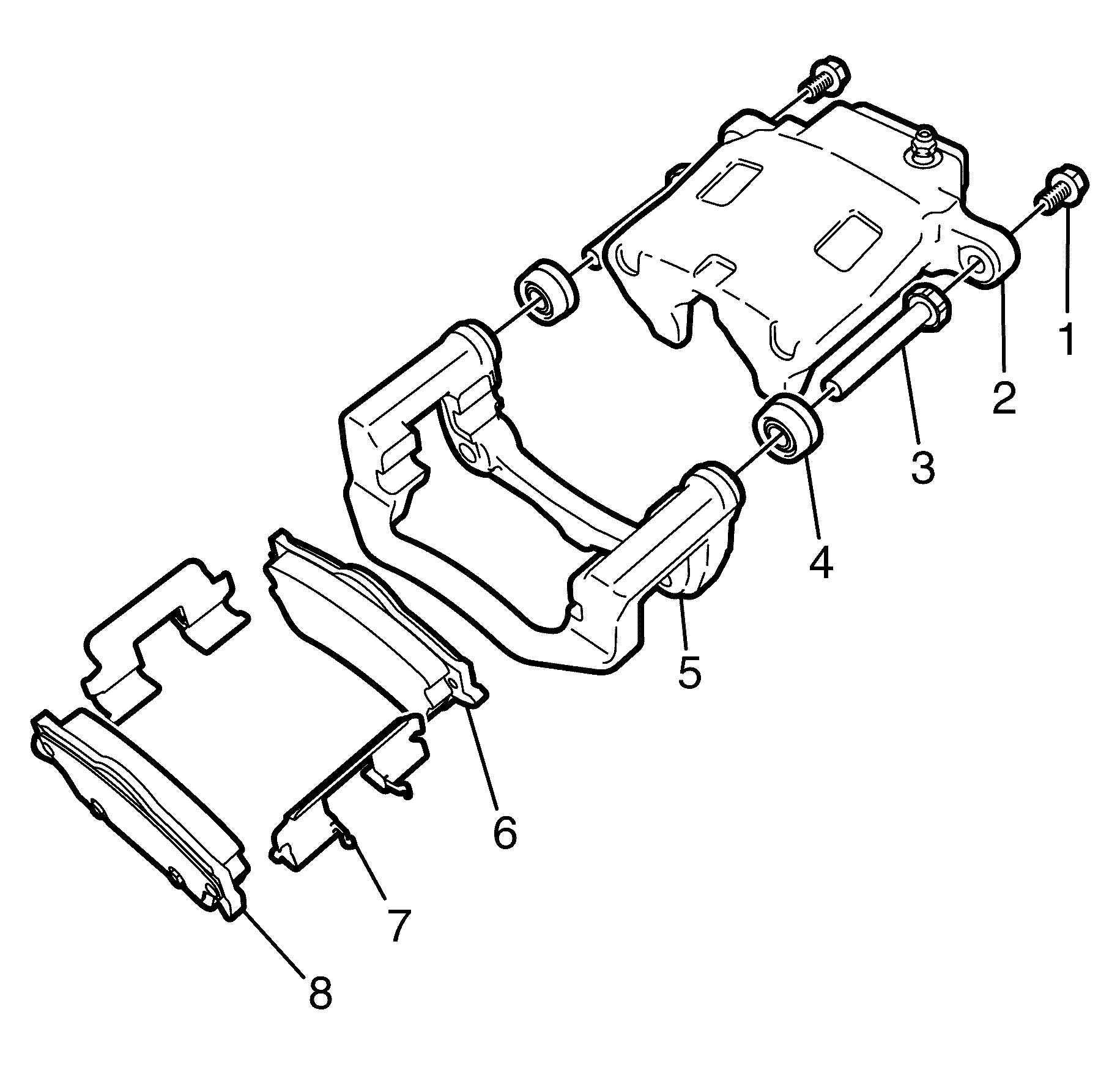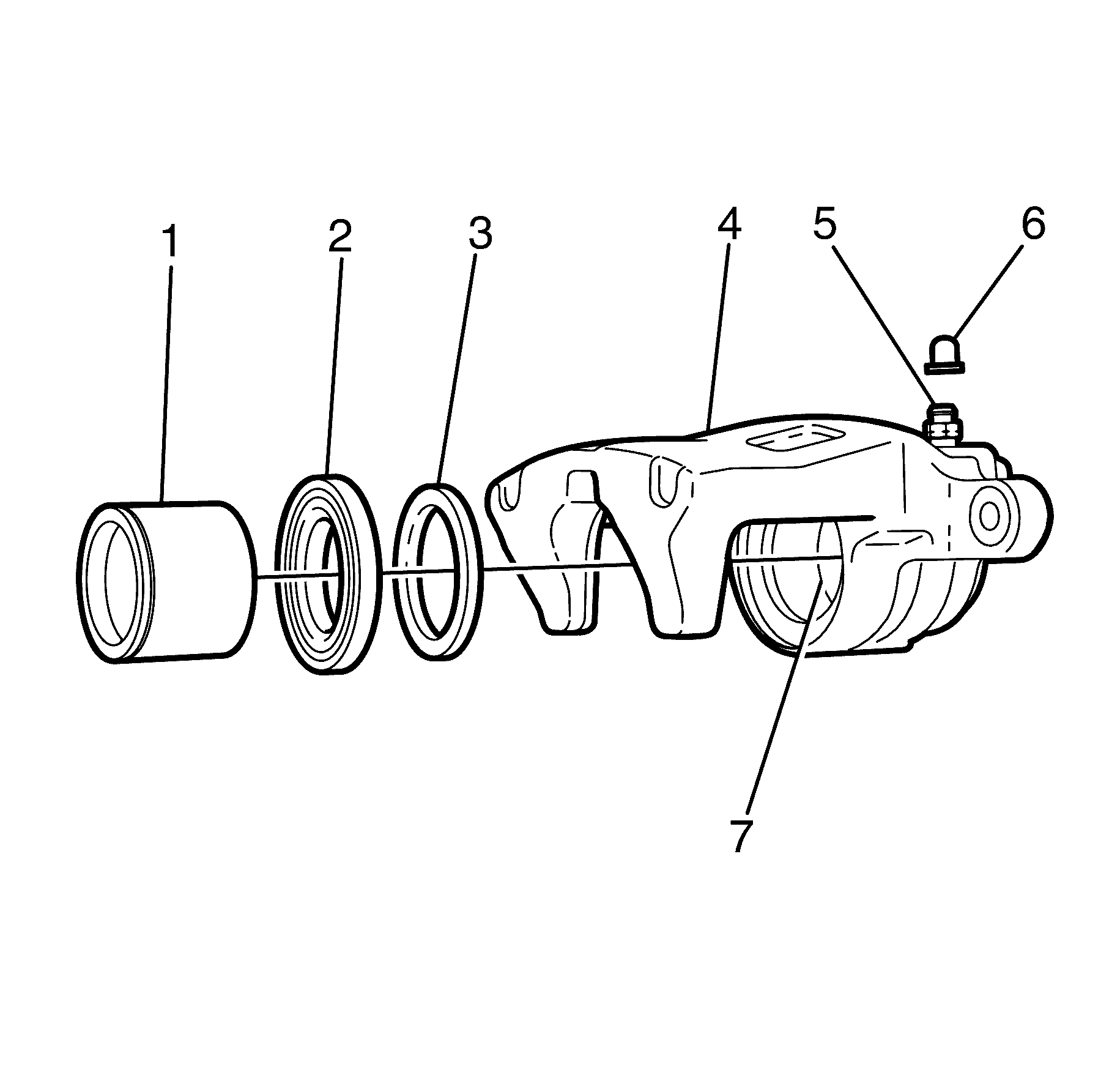Caution: Refer to Brake Fluid Irritant Caution in the Preface section.
Caution: Refer to Brake Dust Caution in the Preface section.
Notice: Refer to Brake Fluid Effects on Paint and Electrical Components Notice in the Preface section.
Disassembly Procedure
Important:
• Replace all the components included in the repair kit used to service
the brake caliper. • Lubricate the rubber parts with NEW HN 1796 brake fluid to make assembly
easier. • If any hydraulic component is removed or disconnected, it may be necessary
to bleed all or part of the brake system. • The torque values specified are for dry, non-lubricated fasteners. • Perform the service operations on a clean bench, free from all mineral
oil materials.
- Remove the brake caliper from the vehicle. Refer to Rear Brake Caliper Replacement .
- Drain the brake fluid from the brake caliper.
- Remove the guide pin retaining bolts (1).
- Separate the brake caliper housing (2) from the brake caliper anchor plate (5).
- Remove the brake pads (6 and 8).
- Remove the retainer clips (7)
- Withdraw the guide pins (3) and dust boots (4) from the brake caliper anchor plate (5).
- Separate the dust boots (4) from the guide pins (3).
- Install clean cloths to pad the interior of the caliper (4) between the caliper piston (1) and the caliper (4).
- Carefully remove the brake caliper piston (1) by directing low pressure compressed air into the brake caliper (1) inlet hole.
- With the brake caliper piston (1) removed, remove the brake caliper piston dust boot seal (2) from the brake caliper (4).
- Remove the brake caliper piston seal (3) from the brake caliper (4) and discard the brake caliper piston seal (3).
- Remove the brake caliper bleeder valve cap (6).
- Remove the brake caliper bleeder valve (5).
- Inspect the brake caliper anchor plate guide surfaces for corrosion and wear. Replace the brake caliper assembly if damaged or worn.
- Clean the brake caliper piston bore (7) with denatured alcohol, or equivalent.
- Clean the brake caliper piston (1) with denatured alcohol, or equivalent.
- Clean the brake caliper bleeder valve (5)
- Dry the brake caliper piston bore (7) with non-lubricated, filtered air.
- Dry the brake caliper piston (1) with non-lubricated, filtered air.
- Dry the brake caliper bleeder valve (5) with non-lubricated, filtered air.
- Inspect the brake caliper bore (7) for cracks, scoring, pitting, too much corrosion.
- If light corrosion is present in the brake caliper bore (7), attempt to remove the imperfection with a fine emery paper. If the imperfection cannot be removed, replace the brake caliper assembly.
- If cracks, scoring, pitting, and too much corrosion are present in the brake caliper bore (7), replace the brake caliper assembly.
- Inspect the brake caliper piston (1) for cracks, scoring, and/or damage, replace the brake caliper piston (1) if any of these conditions exist.

Important: To remove the guide pin bolts (1) use a suitable tool to hold the flat section on the guide pins (3) whilst loosening the guide pin bolts (1).

Caution: Do not place fingers in front of the caliper piston(s) in an attempt to catch or protect it when applying compressed air. The piston(s) can fly out with force and could result in serious bodily injury.
Notice: Use clean cloths to pad interior of caliper housing during piston removal. Use just enough air to ease the pistons out of the bores. If the pistons are blown out, even with the padding provided, it may be damaged.
Important: Use a small wooden or plastic tool to avoid damage to the brake caliper (4).
Important: Brake caliper seals are single use components only and must be discarded after removal.
Discard the brake caliper piston dust boot seal (2).
Discard the brake caliper piston seal (3).
Important: DO NOT use abrasives to clean the brake caliper piston (1).
Caution: Refer to Brake Fluid Irritant Caution in the Preface section.
Caution: Refer to Brake Dust Caution in the Preface section.
Notice: Refer to Brake Fluid Effects on Paint and Electrical Components Notice in the Preface section.
Assembly Procedure
Important:
• Replace all the components included in the repair kit used to service
the brake caliper. • Lubricate the rubber parts with NEW Super DOT 4 or DOT 4 Plus brake fluid
to make assembly easier. • If any hydraulic component is removed or disconnected, it may be necessary
to bleed all or part of the brake system. • The torque values specified are for dry, non-lubricated fasteners. • Perform the service operations on a clean bench, free from all mineral
oil materials.
- Install the brake caliper bleeder valve (6) to the brake caliper (4).
- Install the brake caliper bleeder valve cap (7) to the brake caliper bleeder valve (6).
- Lubricate the NEW brake caliper piston seal (3) with Super DOT 4 or DOT 4 Plus brake fluid from a clean, sealed brake fluid container.
- Install the lubricated brake caliper piston seal (3) into the seal groove in the brake caliper bore (7). Make sure the brake caliper piston seal (3) is not twisted.
- Lubricate the brake caliper bore (7) and the brake caliper piston (1) with brake fluid.
- Install the brake caliper piston (1) into the brake caliper bore (7).
- Install the NEW brake caliper piston dust boot seal (2) over the brake caliper piston (1).
- Complete the following for the brake caliper piston dust boot seal (2).
- Lubricate the guide pins (1) with silicone grease, such as Dow Corning No. 44 or equivalent.
- Install guide pins (1) into the brake caliper anchor plate (5).
- Install the brake caliper (4) to the brake caliper anchor plate (5) and install NEW guide pin bolts (3).
- Use an open-end spanner to hold the guide pin flat section, tighten the NEW guide pin bolts (3) to the correct torque.
- Detach the brake caliper (4) from the brake caliper anchor plate (5) and install the NEW guide pin boots (4) to the guide pins (3).
- Assemble the brake caliper (4) and brake caliper anchor plate (5) together.
- Install the brake pads. Refer to Rear Disc Brake Pads Replacement .
- Install the brake caliper to the vehicle. Refer to Rear Brake Caliper Replacement .
Notice: Refer to Fastener Notice in the Preface section.

Tighten
Tighten the brake caliper bleeder valve when dry
12 Nm (106 lb in).
| 8.1. | Fully seat the brake caliper piston dust boot seal (2) into the brake caliper (4). |
| 8.2. | Make sure the brake caliper piston dust boot seal (2) is correctly seated into the groove in the brake caliper bore (7). |

Do not fit the two guide pin boots (2) at this stage.
Tighten
Tighten the guide pin bolt to 42 Nm (31 lb ft).
Important: Make sure that the brake caliper and guide pins slide in and out easily from the brake caliper anchor plate. If any binding is evident, then steps 9-12 must be repeated.
Important: Remove all excess air from the guide pin boot and make sure that each guide pin boot is correctly located in the guide pin and brake caliper anchor plate grooves.
